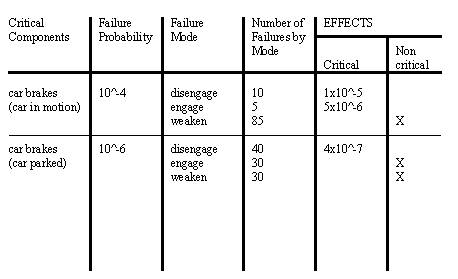11.5.1 Failure Modes and Effects Analysis (FMEA)
• Estimates overall reliability of a detailed or existing product design in terms of probability of failure
• basically, each component is examined for failure modes, and the effects of each failure is considered. In turn, the effects of these failures on other parts of the system is considered.
• the following is a reasonable FMEA chart.

• the basic steps to filling one out is,
1. consider all critical components in a system. These are listed in the critical items column.
2. If a component has more than one operation mode, each of these should be considered individually.
3. estimate failure probability based on sources such as those listed below. Error bounds may also be included in the FMEA figures when numbers are unsure. These figures are entered in the “Failure Probability” column.
- historical data for similar components in similar conditions
4. The failures in a particular operation mode can take a number of forms. Therefore, each mode of failure for a system is considered and its % of total failures is broken down.
5. In this case the table shows failures divided into critical/non-critical (others are possible). The effects are considered, and in the event of critical failures the probabilities are listed and combined to get the overall system reliability.
• Suitable applications include,
- analyze single units or failures to target reliability problems.
- redundant and fail-safe design requirements
- inspection and maintenance requirements
• This technique is very complete, but also time consuming.
• not suited to complex systems where cascaded errors may occur.